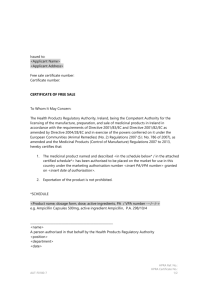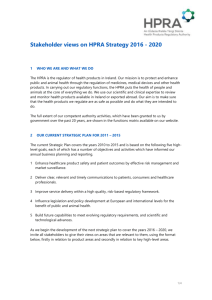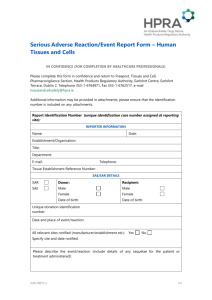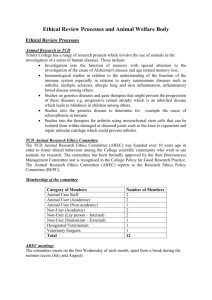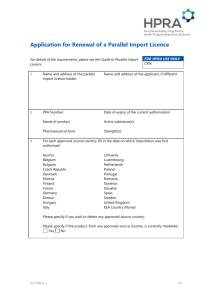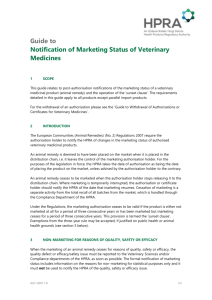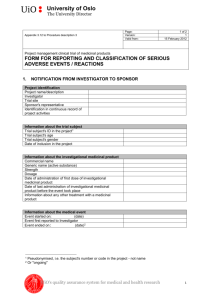Guide to Clinical Trial Applications
advertisement
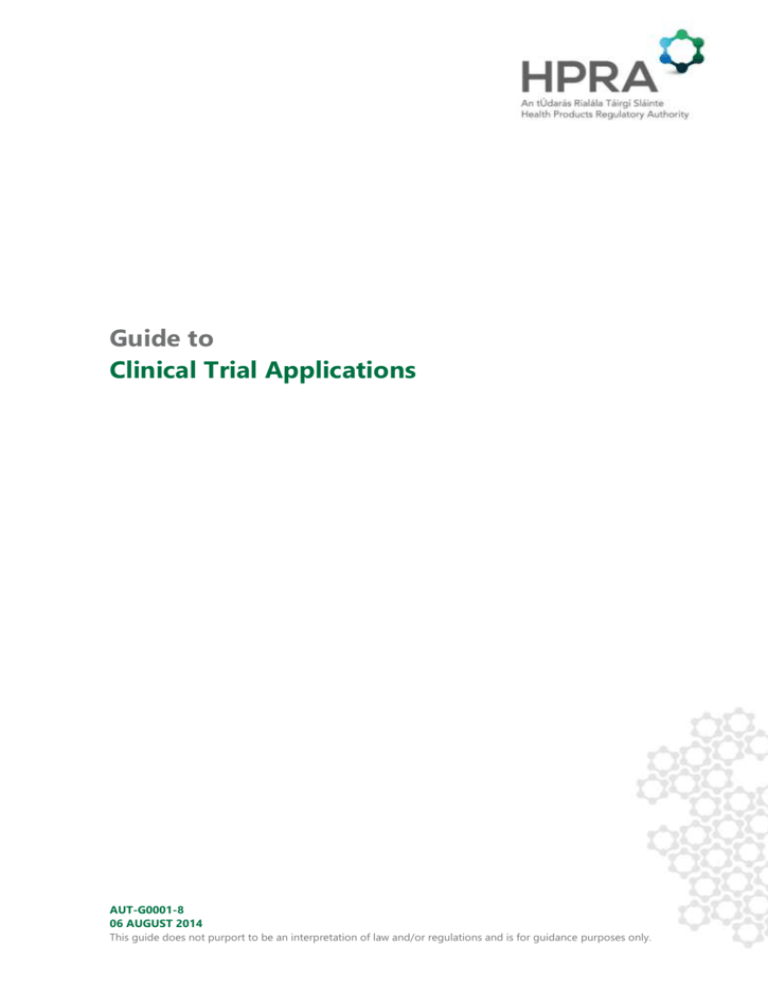
Guide to Clinical Trial Applications AUT-G0001-8 06 AUGUST 2014 This guide does not purport to be an interpretation of law and/or regulations and is for guidance purposes only. HPRA Guide to Clinical Trial Applications CONTENTS ABBREVIATIONS 3 1 SCOPE 4 2 INTRODUCTION 4 3 REQUIREMENT FOR AUTHORISATION BY THE HPRA 5 4 APPLICATIONS FOR CLINICAL TRIAL AUTHORISATION 5 5 AMENDMENTS AND URGENT SAFETY MEASURES 11 6 END OF TRIAL DECLARATIONS 13 7 NOTIFICATION OF ADVERSE REACTIONS/EVENTS 14 8 SUSPENSION OR REVOCATION OF A TRIAL 16 9 APPEALS 17 10 END OF TRIAL REPORT 17 11 ARCHIVING 17 12 GCP INSPECTIONS 18 13 MANUFACTURING AUTHORISATIONS 19 14 ENFORCEMENT 20 APPENDIX 1 FEES AND ADDRESSES FOR THE APPLICATION 21 APPENDIX 2 LINKS TO WEBSITES REFERENCED IN THIS GUIDELINE 23 APPENDIX 3 LIST OF DOCUMENTS FOR SUBMISSION 24 AUT-G0001-8 2/24 HPRA Guide to Clinical Trial Applications ABBREVIATIONS EDI Electronic data interchange EEA European Economic Area (EU and Norway, Iceland and Liechtenstein) EMA European Medicines Agency EU European Union GCP Good clinical practice GMP Good manufacturing practice HMA Heads of Medicines Agencies ICH International Conference on Harmonisation of Technical Requirements for Registration of Pharmaceuticals for Human Use HPRA Health Products Regulatory Authority IMPD Investigational medicinal product dossier ICSR Individual case safety report MPR Medicinal product report RSI Reference safety information SUSARs Suspected unexpected serious adverse reactions SI Statutory Instrument SmPC Summary of product characteristics AUT-G0001-8 3/24 HPRA Guide to Clinical Trial Applications 1 SCOPE This guide covers applications for clinical trials as defined in the European Communities (Clinical Trials on Medicinal Products for Human Use) Regulations, 2004, SI No 190 of 2004. Clinical trials which are outside the scope of the Regulations and therefore of this guide include: - Non-interventional trials which are not subject to legislative control when they meet the definition in Regulation 4 of the Regulations. - Clinical trials involving only medical devices, food supplements, or other non-medicinal therapies (such as surgical interventions). For medical devices, please see the guideline on clinical investigations on the HPRA website. 2 INTRODUCTION This document is intended to give guidance to applicants in making applications for clinical trials on medicinal products for human use to the Health Products Regulatory Authority (HPRA) as competent authority for these Regulations. Guidance on applications to ethics committees is available on the website of the Department of Health. Information on clinical trials using medicinal products containing genetically-modified organisms is available from the Environmental Protection Agency (see ‘GMO Part B Deliberate Release’). (Note that all websites referenced in this document are listed in Appendix 2). Clinical trials in Ireland are governed by the European Communities (Clinical Trials on Medicinal Products for Human Use) Regulations, 2004, SI No 190 of 2004 and amendments. The Regulations transposed into Irish law the provision of Council Directive 2001/20/EC on the approximation of the laws, regulations and administrative provisions of the Member States relating to the implementation of good clinical practice in the conduct of clinical trials on medicinal products for human use. The Control of Clinical Trials Acts 1987 – 1990 for clinical trials using medicinal products are superseded by these Regulations. The definition of a clinical trial in the Regulations covers studies on clinical, pharmacological, pharmacodynamic or pharmacokinetic effects or studies to identify adverse reactions to investigational medicinal products, i.e. Phase I to Phase IV studies. Further guidance on the definition of a clinical trial is available in Eudralex, Volume 10, Guidance Documents Applying to Clinical Trials, Questions and Answers’ available on the website of the European Commission. In particular, the decision tree provided in answer to question 1.1 in the guidance is useful. AUT-G0001-8 4/24 HPRA Guide to Clinical Trial Applications Investigational medicinal products include placebo products and both authorised and unauthorised medicines with any type of active substance, including herbal and homeopathic products. Authorised products may be used in accordance with the terms of the marketing authorisation or used in a different way, e.g. at a higher dose, for a new indication or when packaged in a different container. For additional guidance on making an application for clinical trials and on adverse reaction reporting, applicants should also consult the EU guidelines which are available from the EudraCT website or the website of the European Commission. Applicants should note that the assessment of a clinical trial application and the assessment of any subsequent application for product authorisation for the same medicinal product are two separate assessments. The approval of a clinical trial does not determine the acceptability or otherwise of the marketing authorisation application. 3 REQUIREMENT FOR AUTHORISATION BY THE HPRA According to Regulation 10 of the Regulations, a trial may only be started or conducted in Ireland if: - the ethics committee has issued a favourable opinion - the HPRA has granted an authorisation - the sponsor or legal representative of the sponsor is established within the European Community 4 APPLICATIONS FOR CLINICAL TRIAL AUTHORISATION Applications for clinical trial authorisation should be made by the trial sponsor or a legal representative acting on behalf of the sponsor. Applications should comply with the European Commission’s guideline, ‘Detailed guidance on the request to the competent authorities for authorisation of a clinical trial on a medicinal product for human use, the notification of substantial amendments and the declaration of the end of the trial (CT-1)’ in Chapter 1 of Volume 10 of Eudralex. 4.1 The application Before an application can be submitted to the Board, sponsors must obtain a EudraCT number by logging onto the EudraCT website and following the instructions to obtain a security code and to apply for the EudraCT number. This number, and the e-mail confirmation of the number, must be included with the application. Applications that do not comply with these requirements will not be validated. AUT-G0001-8 5/24 HPRA Guide to Clinical Trial Applications The sponsor should then use this unique EudraCT number to create a EudraCT application form and should ensure that the data provided in the EudraCT application form and the XML file are identical and consistent with the protocol. The submission of the form for ‘Additional National Requirements for a Clinical Trial Authorisation’ is no longer obligatory. In its place, the HPRA has developed a list of documents for submission (see Appendix 3) which can be used to facilitate preparation of a new clinical trial application. The application and all documents must be in the English language. Applications to the HPRA are made by the sponsor or if he is not established in the Community (i.e. EEA countries), his legal representative who is established in the Community, or an applicant authorised by the sponsor to make the application. 4.2 Sponsors and investigators Sponsors As defined in Regulation 4 the ‘sponsor’ is the person who takes responsibility for the initiation, management and/or financing of a clinical trial. The sponsor does not need to be located in an EU Member State but must have a legal representative in the EU. The investigator and the sponsor may be the same person. The sponsor may delegate any or all of his trial-related duties and functions to another person/organisation. Any duties or functions that are delegated to a third party must be documented and specified in writing in the application form, or subsequently by amendment, if changes to proposed arrangements are introduced. The sponsor remains ultimately responsible for ensuring that the conduct of the trial and the data generated complies with relevant Council Directives including 2001/20/EC, 2005/28/EC, 2001/83/EC and the Irish Regulations. For non-commercial multi-centre clinical trials, it is possible to have a local sponsor in addition to an international sponsor. Investigators The relevant ethics committee is responsible for determining the suitability of an investigator and the quality of the facilities at the clinical trial site. 4.3 Investigational medicinal product dossier Quality, non-clinical and clinical supporting data on the investigational medicinal product (IMP) should be provided in the investigational medicinal product dossier (IMPD). For further information please refer to the EU ‘Guidance on Investigational Medicinal Products (IMPs) and other medicinal products used in Clinical Trials’ in Chapter III of Volume 10 of Eudralex. Note AUT-G0001-8 6/24 HPRA Guide to Clinical Trial Applications that IMPs include not only the test product but also comparators, blinded comparators, blinded test products and placebos. The investigator’s brochure shall be presented in a concise, simple, objective, balanced and non-promotional form that permits an unbiased risk-benefit assessment of the appropriateness of the proposed clinical trial. Where the IMP already has a marketing authorisation, the summary of product characteristics (SmPC) may be used instead of the investigator’s brochure (simplified dossier). The IMPD must contain reference safety information (RSI), to be used for assessing the ‘expectedness’ of adverse reactions that occur during a clinical trial. The cover letter submitted with the application should clearly indicate the location of the RSI in the dossier. For authorised products, this is usually within the Summary of Product Characteristics (SmPC) and for unauthorised products, within the investigator’s brochure. If the reference safety information is within the SmPC, the list of expected adverse reactions is contained in Section 4.8 ‘Undesirable Effects’. Please note that relevant safety information may also be contained in other sections of the SmPC, however only Section 4.8 should be used for the purposes of expectedness assessment. If the investigational medicinal product has marketing authorisations in several Member States with different SmPCs, the sponsor should justify its selection of the most appropriate SmPC for the RSI, with reference to subject safety. If the reference safety information is within the investigator’s brochure, it should be in a clearly identified separate section. This section should include a list of expected adverse reactions clearly arranged according to their nature, frequency and severity (e.g. in tabular format). If different indications are being investigated for the investigational medicinal product, separate tables of expected adverse reactions by indication may be appropriate to avoid misinterpretation of information e.g. oncologic indications and immune-mediated indications. If an investigator’s brochure is used as the RSI for an authorised product, any differences between the list of expected adverse reactions in the investigator’s brochure and the SmPC should be highlighted and justified. If any product used in the trial is a genetically-modified organism, a separate application for a licence must be made to the Environmental Protection Agency. For further details, please contact the agency. A copy of the licence from the agency should be provided with the clinical trial application. Medicinal products used in the context of a clinical trial and not falling within the definition of an IMP are ‘non-investigational medicinal products’ (NIMPs). The borderline between IMPs and NIMPs and the requirements for NIMPs is described in the EU guideline mentioned above in this section. AUT-G0001-8 7/24 HPRA Guide to Clinical Trial Applications If any product used in the trial requires a medical device for its administration or utilisation refer to Eudralex, Volume 10, Guidance Documents Applying to Clinical Trials, Questions and Answers’. 4.4 Labelling of the investigational medicinal product The labels of the immediate and outer container should comply with the requirements of Annex 13 to the EU Guide to Good Manufacturing Practices on ‘Manufacture of Investigational Medicinal Products’ in Chapter III of Volume 10 of Eudralex. Label text must be in English. Other languages may be included, though as far as possible, the text for each language should be placed together on the label, rather than placing all language versions of each statement together. In relation to any changes to the expiry date on the label, the HPRA requires that an additional label be fixed to the outer carton, with the new expiry date, the same original batch number and an explanatory statement highlighting the fact that the expiry date shown on the over-label is a new, approved date, and that the earlier expiry date on the outer and immediate packaging has been superseded. This over-label should not cover either the old use-by date or the original batch number. Any extension to the shelf-life is subject to the submission of an amendment, unless otherwise agreed at the time of the original clinical trial application. 4.5 Subject information and the informed consent procedure The subject information leaflet and informed consent form should not be submitted to the HPRA for information. The relevant ethics committee is responsible for providing an opinion on these documents. 4.6 Ethics committee opinion In order for a clinical trial record to be released into the EU Clinical Trials Register, the decision taken by the competent authority on completion of the initial assessment (authorised/ refused / withdrawn), the opinion of the ethics committee (favourable/ notfavourable/withdrawn) and their respective dates must be logged on the EudraCT database by the HPRA. The applicant must provide details of the ethics committee opinion to the HPRA as soon as it is available to ensure that all Irish records are released and published on the EU Clinical Trials Register. 4.7 Procedures for processing of the application The procedures for authorisation of clinical trials depend on the type of investigational medicinal product in the study. There are two categories of trials: - general medicinal products, biological and biotechnological products AUT-G0001-8 8/24 HPRA Guide to Clinical Trial Applications - advanced therapy medicinal products (gene therapy, somatic cell therapy, tissue engineered products as defined in Article 2 of Regulation (EC) No 1394/2007), or products containing genetically modified organisms General, biological and biotechnological medicinal products On receipt, applications are validated in order to check that all the required documentation is present. If documents are missing, the applicant is asked to supply them, and the application is not progressed further until they are provided. Once validated, the application is assessed and within 25 days of receipt of a valid application, written notice is sent to the applicant setting out either acceptance of the request for authorisation, with conditions if necessary, or grounds for non-acceptance of the request. If grounds for non-acceptance are sent, the applicant must respond with an amended request (i.e., a response to grounds for non-acceptance) within 14 days. Following assessment of the response and within 60 days of the original request, written notice is sent to the applicant setting out either acceptance of the request for authorisation, with conditions if necessary, or grounds for non-acceptance of the request. Applicants should note that the Regulations allow for only one cycle of correspondence on any queries which arise from the assessment. If a response is not submitted or the response is not acceptable, the application is treated as rejected (alternatively the sponsor may withdraw the application before day 60). Applicants may contact the HPRA, if necessary, to discuss their responses before submitting them, in order to clarify the changes which are required. Advanced therapy medicinal products and genetically modified organisms For advanced therapy medicinal product clinical trials and trials using genetically modified organisms, the HPRA strongly recommends that the applicant requests a pre-submission meeting to discuss the potential clinical trial submission. The HPRA may consult with its experts before issuing the written authorisation for these trials. The timelines for this procedure are as given below: On receipt, applications are validated in order to check that all the required documentation is present. If documents are missing, the applicant is asked to supply them, and the application is not progressed further until they are provided. Once validated, the application is assessed and within 30 days of receipt of a valid application, written notice is sent to the applicant setting out either acceptance of the request for authorisation, with conditions if necessary, or grounds for non-acceptance of the request. If grounds for non-acceptance are sent, the applicant should respond with an amended request (i.e., a response to grounds for non-acceptance) within 30 days (or longer if the HPRA agrees). AUT-G0001-8 9/24 HPRA Guide to Clinical Trial Applications The response is assessed by the assessors and by the Clinical Trials Subcommittee. Within 90 days of the original request, written authorisation is sent to the applicant setting out either acceptance of the request for authorisation, with conditions if necessary, or grounds for nonacceptance of the request. Note: This timeframe may be extended in certain instances by an additional 90 days as per Article 16.2 of the Regulations. The applicant will be notified in writing if the timeline is to be extended. Applications involving products for xenogenic cell therapy are not subject to any timelines, as provided for in Regulation 16(9) of the Regulations. All application types The EudraCT database, accessible to all competent authorities of Member States, is updated with the outcome of the process. 4.8 Voluntary Harmonisation Procedure for the assessment of multinational clinical trial applications The Voluntary Harmonisation Procedure (VHP) is a procedure which makes it possible to obtain a coordinated assessment of an application for a clinical trial that is to take place in several European countries. It consists of the submission of a common dossier to the VHP Coordinator and a coordinated assessment performed by the national competent authorities concerned. After the VHP, a national clinical trial application needs to be submitted by the sponsor according to the national laws for the approval of clinical trials. In the case of a positive outcome from the VHP, the national approval procedure should not take longer than 10 days after the submission of a valid application. For detailed information on the process and requirements please refer to the guidance ‘Guidance document for a Voluntary Harmonisation Procedure (VHP) for the assessment of multinational Clinical Trial Applications’ on the HMA website. 4.9 Pharmacogenetic Research Pharmacogenetic research investigates how genetic variation affects the clinical response to a drug, with the assumption that such knowledge could enhance the efficacy while reducing toxicity. Clinical trials where samples for pharmacogenetic research are to be collected must comply with GCP. The subject information leaflet and informed consent form must be submitted to the relevant ethics committee for opinion. Pharmacogenetic research must comply with data protection requirements. Further information on pharmacogenetic research is available on the EMA and ICH websites. AUT-G0001-8 10/24 HPRA Guide to Clinical Trial Applications 5 AMENDMENTS AND URGENT SAFETY MEASURES 5.1 Amendments by the HPRA The HPRA may require amendments to be made to the conduct of the trial to ensure compliance with GCP or to ensure the safety or scientific validity of the trials. Where an amendment is required, the Board will serve notice on the sponsor that a specified amendment is required in 14 days, and will give the reason for the proposal. The sponsor may make written representations to the HPRA within the 14 days, which will be taken into account in the final decision by the Board. In order to consider the sponsor’s response, the Board may delay the date on which the proposed amendment is to take effect. 5.2 Amendments by the sponsor Substantial amendments Amendments to a trial are regarded as ‘substantial’ where they are likely to have a significant impact on the safety or physical or mental integrity of the clinical trial participants, or the scientific value of the trial. It is up to the sponsor to assess whether an amendment is to be regarded as substantial. Substantial amendments to the application or any accompanying documentation must be notified to the HPRA using the EU ’Substantial Amendment Notification Form.’ Further information on substantial amendments is provided in the EU “Detailed guidance on the request to the competent authorities for authorisation of a clinical trial on a medicinal product for human use, the notification of substantial amendments and the declaration of the end of the trial, (CT-1). Any change to the RSI is considered a substantial amendment and should be justified with supporting data. Amendments to the RSI should be clearly indicated using track change formatting and mentioned in the cover letter. It is recommended that amendments to the RSI are done in alignment with the development safety update report (DSUR). In this way the DSUR can act in part as justification for the RSI changes, and the basis for expectedness can remain consistent for the reporting period. If the RSI is updated prior to the end of the reporting period of the DSUR, detailed justification with supporting data is required. Non-substantial amendments Non-substantial amendments do not have to be notified to the HPRA, however they must be recorded and submitted with a subsequent substantial amendment notification. This is particularly important for the Clinical Trial Application Form which should be updated in its entirety on the occasion of a substantial amendment. The updated form (XML file) should be submitted to the HPRA so that the EudraCT database can be updated. AUT-G0001-8 11/24 HPRA Guide to Clinical Trial Applications Changes to the trial site or investigator Substantial amendments relating to the clinical trial site or the investigator which are required to be sent to the ethics committee should be notified to the HPRA following approval by the ethics committee. A revised XML file with an updated list of approved trial sites/investigators (Section G) should be submitted as part of the next substantial amendment application for the trial. Updates to the investigator’s brochure In accordance with the legislation, the investigator’s brochure is required to be validated and updated at least once a year. Revisions should be clearly indicated and justified. In particular, any change in the 'expectedness' of an adverse drug reaction, including any increase in the specificity or severity of a previously expected reaction should be addressed in the RSI. For ongoing trials, if the RSI is not in a clearly identified separate section with the list of expected adverse reactions clearly arranged according to their nature, frequency and severity (e.g. in tabular format), this should be implemented at the next update. Revisions to the investigator’s brochure can be substantial or non-substantial. The sponsor should verify which revisions are substantial and submit these as substantial amendments. If a decision cannot be made regarding the classification of an update as substantial or nonsubstantial, the sponsor is advised to submit the revised investigator’s brochure as a substantial amendment to the HPRA. In addition, comment should be provided on the impact of any updates on the study and consequential substantial amendments to the protocol and/or patient information leaflet should be submitted where necessary. Documentation Amendment applications consist of: - Covering letter, including the EudraCT number, the CT number assigned by the HPRA, the protocol number(s) affected by the amendment and the trial title - EU ‘Substantial Amendment Notification Form’, - Relevant extracts of the documents that are changed, highlighting current and proposed wording, where applicable, - New version of documents (including the Clinical Trial Application Form) if changes are made - Supporting data A substantial amendment application may cover an amended document in more than one clinical trial application which uses the same active substance, or it may cover a number of amendments to different documents in the same clinical trial application. Where the amendment relates to a number of clinical trial applications, the EudraCT numbers, CT numbers, and protocol numbers must be clearly indicated in the cover letter. AUT-G0001-8 12/24 HPRA Guide to Clinical Trial Applications Amendments to information that is assessed by both the HPRA and the ethics committee should be submitted in parallel to both organisations. Documentation on non-substantial and substantial amendments should be available on request for inspection at the trial site and/or the sponsor’s premises, as appropriate. Procedure for substantial amendments Once validated, the application is assessed and, within 35 days of receipt of a valid application, written notice is sent to the applicant setting out either acceptance of the request for authorisation, with conditions if necessary, or grounds for non-acceptance of the request. If grounds for non-acceptance are sent, the applicant must respond with an amended request (i.e., a response to grounds for non-acceptance) not later than 30 days after receiving the grounds for non-acceptance and at least 14 days before the amendment is due to be made. Following assessment of the response and within 14 days of receipt of the response, written notice is sent to the applicant setting out either acceptance of the request for authorisation, with conditions if necessary, or grounds for non-acceptance of the request. 5.3 Urgent safety measures If the sponsor and investigators consider that urgent safety measures need to be taken to protect the health or safety of trial subjects, the sponsor should notify the Board in writing no later than three days after the date the measures were taken. The notification should specify the measures taken, the reasons for them and the plan for further action and should be sent to clinicaltrials@hpra.ie. Urgent safety measures notified by telephone must be also be notified in writing no later than three days after the date the measures were taken. An amendment detailing the changes to the clinical trial documents should be submitted to the HPRA as soon as possible after the implementation of urgent safety measures. A temporary halt to a trial can be a substantial amendment or part of an urgent safety measure. The restart of the trial should be treated as a substantial amendment with evidence provided that it is safe to restart the trial. 6 END OF TRIAL DECLARATIONS The end of a trial, whether it ends earlier than planned or according to the protocol, must be notified to the HPRA using the EU Declaration of the End of Trial Form. The form should be submitted when the trial has ended in all countries in which the trial was taking place. If a trial ends in Ireland before the trial has ended globally, it is recommended that sponsor notifies the HPRA in writing as justification for no longer submitting amendments or Development Safety Update Reports (DSURs).This local end of trial date is also published in the EU Clinical Trials Register. AUT-G0001-8 13/24 HPRA Guide to Clinical Trial Applications The form should be received within 90 days of the end of the clinical trial or within 15 days if it has ended earlier than planned. 7 NOTIFICATION OF ADVERSE REACTIONS/EVENTS 7.1 Reporting suspected unexpected serious adverse reactions Suspected unexpected serious adverse reactions (SUSARs) occurring during clinical trials undertaken in Ireland should be notified electronically and in parallel to both the HPRA and the Clinical Trials module of the Eudravigilance database (EVCTM) by investigators or sponsor pharmaceutical companies, in accordance with the ‘Detailed guidance on the collection, verification and presentation of adverse reaction reports arising from clinical trials on medicinal products for human use, CT-3’ and the requirements specified in the HPRA ‘Guide to Electronic Submission of ICSRs and SUSARs Associated with the Use of Human Medicines’. Paper reporting should be exceptional and in line with the ‘Note for Guidance on the Electronic Data Interchange (EDI) of Individual Case Safety Reports (ICSRs) and Medicinal Product Reports (MRPs) in Pharmacovigilance during the pre- and post-authorisation phase in the European Economic Area.’ Whichever form/format is used, it is important that the basic information/data elements described in Annex 3 of the above detailed guidance are included, when available, in any expedited report. In exceptional cases, the HPRA will assist academic sponsors with electronic report submission to EVCTM if necessary. In such cases, a request should be submitted to medsafety@hpra.ie at the time of submission of the CT application, to facilitate timely completion of arrangements The timelines for expedited reporting are shown on the next page. The timelines start as soon as the sponsor has first knowledge of the minimum criteria required for expedited reporting. The timelines also re-start if/when additional case information becomes available. Other safety issues requiring expedited reporting should be notified in accordance with the criteria defined in the above detailed guidance document. As a general rule treatment codes should be broken/unblinded by the sponsor before reporting a SUSAR. However, in certain circumstances (e.g. trials in high morbidity or high mortality conditions where efficacy endpoints could also meet the criteria for reporting as SUSARs) and where it is considered that the integrity of the trial may be compromised if the blind is systematically broken, sponsors should seek prior approval from the HPRA regarding proposed arrangements for reporting of SUSARs. In such cases, an independent Drug Safety Monitoring Board is recommended. AUT-G0001-8 14/24 HPRA Guide to Clinical Trial Applications All SUSARs Fatal and lifethreatening SUSARs 7.2 All other SUSARs Fatal and lifethreatening SUSARs HPRA and EVCTM A Further 8 days for completed report HPRA and EVCTM Fatal and lifethreatening SUSARs Monitoring and reporting of adverse events The sponsor is required to keep detailed records of all adverse events relating to a clinical trial which are reported to him or her by the investigators for that trial. The HPRA is entitled to request these records. 7.3 Line listings Copies of line listings submitted to ethics committees, either quarterly or six-monthly, are not routinely required by the HPRA. However it should be noted that copies of these line listings may be requested and, as such, should be made available to the HPRA when required. 7.4 Development Safety Update Reports In addition to the expedited reporting requirements of individual SUSARs, sponsors are required to submit once a year or on request a safety report to the HPRA. Since September 2011, the Development Safety Update Report (DSUR) has replaced the EU Annual Safety Update Report and differs from it in a number of ways. For example, there is a common birth date, the Development International Birth Date (DIBD), the report includes information on the marketing authorisation status worldwide, the cumulative exposure in clinical trials and marketing experience (if applicable), and a summary of the important risks. The main objective of a DSUR is to present a comprehensive, thoughtful annual review and evaluation of pertinent safety information collected during the reporting period related to a drug under investigation, whether or not it is marketed, by: (1) examining whether the AUT-G0001-8 15/24 HPRA Guide to Clinical Trial Applications information obtained by the sponsor during the reporting period is in accord with previous knowledge of the investigational drug’s safety; (2) describing new safety issues that could have an impact on the protection of clinical trial subjects; (3) summarising the current understanding and management of identified and potential risks; and (4) providing an update on the status of the clinical investigation/development programme and study results. A DSUR should be concise and provide information to assure regulators that sponsors are adequately monitoring and evaluating the evolving safety profile of the investigational drug. All safety issues discovered during the reporting period should be discussed in the text of the DSUR; however, it should not be used to provide the initial notification of significant new safety information or provide the means by which new safety issues are detected. Guidance on the preparation on the report is provided in ICH Guideline E2F in Chapter II of Volume 10 of Eudralex. A DSUR should not be submitted as a substantial amendment; however the sponsor is required to verify whether the data presented in the report require a change to the documentation submitted with the request for authorisation of the clinical trial. If this amendment is substantial, the rules for notification of substantial amendments apply to these changes. A DSUR is required to be submitted annually to the HPRA until after the last visit of the last patient in Ireland or until the trial has ended in Ireland as defined in the protocol. A safety evaluation, including data from the entire duration of the trial, should be included in the End of Trial Report (see section 10). 8 SUSPENSION OR REVOCATION OF A TRIAL The HPRA may issue a notice to suspend or end the trial or to end it at one or more trial sites if it considers that: - the conditions of the approval or of application itself are not complied with, or - there are doubts over the safety or scientific validity of the study, or - there are doubts over the conduct of the trial at a particular site. The notice will be sent to the sponsor, or the investigator at each site or particular sites as appropriate. It will specify the actions to be taken, the duration of the actions and the conditions which must be satisfied before the trial may recommence. The relevant ethics committee, other Member States, the EMA and the European Commission will also be informed. The notice will be sent with immediate effect if the Board considers that there is an imminent risk to the health or safety of trial subjects. Otherwise the sponsor or investigator will be AUT-G0001-8 16/24 HPRA Guide to Clinical Trial Applications notified at least one week in advance and given the opportunity to make representations to the Board. Any issued notice remains in force, even if appealed. The suspension or revocation of a trial in another Member State may impact on the authorisation of similar trials in Ireland. The EudraCT database is updated following suspension, revocation or early termination, temporary halt or re-start of a clinical trial. 9 APPEALS A sponsor may appeal the decision of the HPRA to the HPRA’s Advisory Committee for Human Medicine in the following cases where the Board has: - authorised a trial with certain conditions - issued grounds for not accepting a request for authorisation or for amendment of the authorisation after the sponsor has amended the request - amended a trial authorisation - issued a notice for suspension or termination of a trial An appeal must be sent within 28 days of the HPRA’s decision, unless further time is requested and granted. The appeal will be considered by the committee, which will report its findings to the Board. The Board will notify the sponsor of the outcome of its deliberations. 10 END OF TRIAL REPORT Within one year of the date of completion or cancellation of the trial, an end of trial report should be submitted. This applies if the trial is completed or terminated prematurely. The format of this summary should comply with the EU Note for Guidance on Structure and Content of Clinical Study reports (CPMP/ICH/137/95), available on the website of the European Medicines Agency. - 11 When the trial is terminated prematurely, the end of clinical trial report should also provide the following information: Justification of the premature ending of the trial Number of patients still receiving treatment at time of study termination, Proposed management of patients receiving treatment at time of study termination Consequences for the evaluation of results. ARCHIVING The sponsor and the investigators are required to retain the essential documents relating to a clinical trial for at least five years after its completion. The essential documents are defined as AUT-G0001-8 17/24 HPRA Guide to Clinical Trial Applications those that individually and collectively permit evaluation of the conduct of the trial and the quality of the data produced. These documents should be filed in an organised way that facilitates management of the clinical trial, audit and inspection by competent authorities and should be readily available on request. The HPRA requires that if an end of trial report has not been submitted (see Section 10 above) then the essential documents should be retained indefinitely. Sponsors and investigators may be required by other applicable requirements to retain the essential documents for more than five years. Further information is available in the EU guideline on ‘Recommendation on the trial documentation and archiving.’ The requirements for marketing authorisation holders to arrange for the retention of retain essential clinical trial documents by the owners of the data are outlined in Commission Directive 2003/63/EC (in Volume 1 of Eudralex). 12 GCP INSPECTIONS Good clinical practice (GCP) is a set of internationally recognised ethical and scientific quality requirements that must be observed for designing, conducting, recording and reporting clinical trials that involve the participation of human subjects. Compliance with GCP provides assurance that the rights, safety and well being of trial subjects are protected, and that the results of the clinical trials are accurate and credible. The Regulations require that all clinical trials covered by the provisions of the Regulations, including bioavailability and bioequivalence studies, are designed, conducted and reported in accordance with the principles of GCP. In addition to the principles of GCP, clinical trial sponsors should take into account other applicable Community guidelines relating to the quality, safety and efficacy of medicinal products for human use and updates as adopted by the CPMP, for example, the ‘Note for Guidance on Good Clinical Practice (CPMP/ICH/135/95)’ and the ‘Detailed Guidance on the Collection, Verification and Presentation of Adverse Reaction Reports arising from Clinical Trials on Medicinal Products for Human Use, CT-3.’ Annex 13 to the ‘GMP Guide on Manufacture of Investigational Medicinal Products’ should be complied with. In accordance with Article 15(1) of Directive 2001/20/EC, any site involved in a clinical trial, particularly the investigator sites, the manufacturing sites of the investigational medicinal product, any laboratory used for clinical trial analyses and the sponsor’s premises may be subject to inspection. Contract research organisations/contractors acting under arrangements with a sponsor to perform some or all of the functions of the sponsor of a clinical trial may also be subject to GCP inspection. AUT-G0001-8 18/24 HPRA Guide to Clinical Trial Applications Inspections may be conducted on a routine basis, or may arise as a result of a specific trigger. Inspections may be conducted on ongoing or completed studies and may be announced or unannounced, however they are generally announced. In general, inspectees will be given approximately one month’s notice of a forthcoming inspection. The following information may be requested from the inspectee prior to the inspection: - Patient status per trial site (number randomised, drop-out rate, and number of serious adverse reactions reported per site). - Copies of company standard operating procedures e.g. (monitoring procedure, informed consent procedure, serious adverse event reporting procedure, drug supply management procedure). - Trial-specific documents such as a copy of the current protocol and informed consent form, source data verification guidelines, product handling instructions, laboratory manual, randomisation code breaking procedure, monitoring plans and reports. - Job descriptions and CVs of key site and sponsor personnel - Any other documentation deemed necessary by the inspectors An inspection plan, outlining the units to be inspected, the time and duration for each major inspection activity and the schedule of meetings to be held with the investigator and/or sponsor personnel, will be provided to the inspectee prior to the inspection. In accordance with the legislation, the trial master file comprising the essential documents which enable both the conduct of the trial and the quality of the data produced to be evaluated must be available and shall provide the basis for the GCP inspection. The conduct of a GCP inspection can vary depending on the scope and objectives of the inspection. After an inspection, a report is issued to the inspectee. Responses to the report should be provided within 30 working days of the date of issue. Once all findings and observations of the inspection have been addressed satisfactorily, the inspectee will be advised that the inspection is closed. 13 MANUFACTURING AUTHORISATIONS Investigational medicinal products used in trials must be manufactured in accordance with the requirements of the EU Guide to Good Manufacturing Practice. Each company responsible for manufacture (including assembly or batch release) must have a manufacturing authorisation which covers the investigational medicinal product. The authorisation is issued by the competent authority in the Member State (including EEA countries) where the company is situated and it must show that the manufacturer is authorised to manufacture or assemble the relevant pharmaceutical form (e.g., solid dose forms, solutions for injection, etc). Manufacturing authorisations for all manufacturing, assembly and batch release sites must be provided as part of an application to conduct a trial. AUT-G0001-8 19/24 HPRA Guide to Clinical Trial Applications Where a product is made outside the EU/EEA, the company which imports it into the EU/EEA must hold a manufacturing authorisation for this ‘third-country’ importation. The qualified person in the importing manufacturing company must satisfy him/herself of the GMP status of the manufacturing site outside the EU/EEA. The HPRA also reserves the right to conduct GMP inspections at such sites. With the exception of comparator products, it is not necessary for batches of investigational medicinal products to be re-tested on importation into the EU. Where the importer does not have access to the original manufacturer of a comparator product or, to the manufacturer's certification of the batch(es) concerned, each such batch of comparator should be tested on importation. In all cases, each imported batch of an investigational medicinal product must be released for use by the qualified person of the manufacturer responsible for batch release. The Regulations provide for an exemption from the need for a manufacturing authorisation for certain manufacturing operations carried out in hospitals. No authorisation is needed for labelling, packaging or re-packaging (including re-constitution) of a product by a doctor, pharmacist or other person acting under the supervision of a pharmacist, when the product is for use only in the hospital by a resident patient or an out-patient. 14 ENFORCEMENT The HPRA is the responsible body for enforcement of the regulations and may prosecute for any offences committed. The Board may also issue infringement notices where it has objective grounds for considering that any person has contravened any provision of the regulations. AUT-G0001-8 20/24 HPRA Guide to Clinical Trial Applications APPENDIX 1 FEES AND ADDRESSES FOR THE APPLICATION The HPRA strongly recommends electronic submission of clinical trial and related information in line with the ‘Guide to Electronic Submissions - Human Medicines’. Address for applications for clinical trial authorisation or amendment and development safety update reports submissions@hpra.ie or HPRA Receipts and Validation section Health Products Regulatory Authority Kevin O’Malley House Earlsfort Centre Earlsfort Terrace Dublin 2 Address for submission of urgent safety restrictions, end-of-trial declarations, reports, and for responses to grounds for non-acceptance letters clinicaltrials@hpra.ie or Clinical Trials Unit Health Products Regulatory Authority Kevin O’Malley House Earlsfort Centre Earlsfort Terrace Dublin 2 Address for reporting adverse reactions and SUSARs associated with protocol breaches or deviations medsafety@hpra.ie or Pharmacovigilance Section Health Products Regulatory Authority Kevin O’Malley House Earlsfort Centre Earlsfort Terrace Dublin 2 or AUT-G0001-8 21/24 HPRA Guide to Clinical Trial Applications Fax: +353 1 676 2517 Address for manufacturing authorisation applications and amendments compliance@hpra.ie or Compliance Department Health Products Regulatory Authority Kevin O’Malley House Earlsfort Centre Earlsfort Terrace Dublin 2 Fees for applications The HPRA ‘Guide to Fees for Human Products’, the ‘Fee application form’ for human products and details on payment are available from the ‘Publications and Forms’ section of www.hpra.ie. Payment is to be made with the clinical trial application. Fees are payable to the account of the Health Products Regulatory Authority. Account no.: 33712185; sort code 93-10-12 Allied Irish Bank 1-3 Baggot Street Lower Dublin 2 Clinical trials applications as well as substantial amendments of former VHP trials can be submitted to the VHP Coordinator: VHP-CTFG@VHP-CTFG.eu. AUT-G0001-8 22/24 HPRA Guide to Clinical Trial Applications APPENDIX 2 LINKS TO WEBSITES REFERENCED IN THIS GUIDELINE Website of the European Commission, Eudralex Volume 10: Clinical Trials contains: - Chapter 1 Application and Application Form - Chapter II Monitoring and Pharmacovigilance - Chapter III Quality of the Investigational Medicinal Product - Chapter IV Inspections - Chapter V Additional Information (includes Questions and Answers Document referenced in section 2 of this guideline) Other European legislation is available in Volume 1 of Eudralex. Website of the European Medicines Agency contains scientific guidelines as referenced in this guideline. Please see the ‘Publications and Forms’ section of www.hpra.ie for the following information on clinical trials: - Clinical Trial Subcommittee meeting dates and submission cut-off dates, for each year - ‘Terms of Reference and Rules of Procedure of the Clinical Trial Subcommittee’ - ‘Guide to Clinical Trial Applications’ - ‘Clinical Trial Protocol Template’ (annotated with guidance for investigator-led trials) Website of the Department of Health contains: - European legislation - National legislation - Guidance for ethics committees Website of HMA contains: - Information on the Clinical Trials Facilitation Group - Documents produced by the group, including the guidance document for the voluntary harmonisation procedure referred to in section 4.8 of this guideline) EudraCT is a database of all clinical trials commencing in the Community from 1 May 2004. Website of the ICH contains: - Quality, safety and efficacy and multidisciplinary guidelines and definitions Website of the EU Clinical Trials Register contains publicly available information on interventional clinical trials on medicines. Website of the Environmental Protection Agency AUT-G0001-8 23/24 HPRA Guide to Clinical Trial Applications APPENDIX 3 LIST OF DOCUMENTS FOR SUBMISSION Please see below the list of documents for submission of a new Clinical Trial application. 1 Receipt of confirmation of EudraCT number 2 Cover letter, ‘in accordance with CT-1. The letter should indicate the specific features of the trial population such as trial participants not able to give informed consent or minors and whether the trial involves the first administration of a new active substance to humans’ 3 Valid EudraCT XML file 4 EudraCT application form (signed copy) 5 If the applicant is not the sponsor, a letter of authorisation enabling the applicant to act on behalf of the sponsor 6 Protocol (with all current amendments), including summary 7 Investigator’s Brochure 8 Investigational Medicinal Product Dossier (IMPD)/ Simplified IMPD (incl. Section 2.1 Pharmaceutical information, Section 2.2 Pre-Clinical information, Section 2.3 Clinical Information) a) Summary of Product Characteristics (SmPC) for products with marketing authorisation in the Community 9 Non-investigational medicinal (NIMP) dossier (if required) 10 Copy of the ethics committee opinion 11 Summary of scientific advice from any Member Sate or the European Medicines Agency (EMA) for this trial 12 Copy of the EMA decision on the Paediatric Investigational Plan (PIP), where relevant 13 a) Copy of manufacturing authorisation(s) if IMP is manufactured and/or batch released in the EU/EEA b) Copy of authorisation to cover trials or products with special characteristics e.g. GMOs, radiopharmaceuticals c) Declaration of the QP that the manufacturing site operates in compliance with GMP at least equivalent to EU GMP, if manufactured outside the EU/EEA d) Declaration of GMP status of active biological substances 14 Examples of labelling 15 HPRA fee form and proof of payment AUT-G0001-8 24/24
